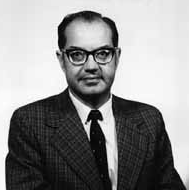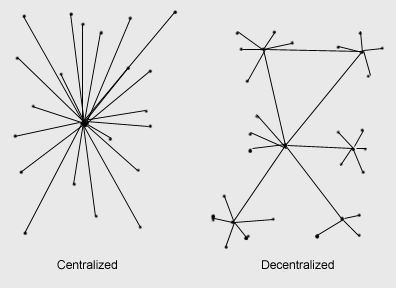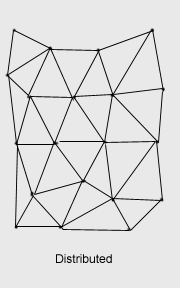Several
years before the ARPANET was created, Paul Baran had  two ideas that became very important in the development of the ARPANET.
The first was the idea of building a distributed network. The second
was a technique for data transmission that later came to be called
packet switching.
two ideas that became very important in the development of the ARPANET.
The first was the idea of building a distributed network. The second
was a technique for data transmission that later came to be called
packet switching.
Early
Years
Paul
Baran was born in Poland in 1926. In 1928, his family moved to the
United States-first in Boston then in Philadelphia where his father
owned a small grocery store. As a child, Baran delivered groceries
for his father in his little red wagon. When he graduated from high
school he attended Drexel University where he earned a degree in electrical
engineering.
When
he left Drexel, Baran took a job as a technician at the Eckert-Mauchly
Computer Corporation. Soon after he married and moved with his wife
to Los Angeles where he got a job at the Hughes Aircraft Company.
He began taking night classes at UCLA and earned a master's degree
in engineering in 1959. In that same year he left Hughes Aircraft
and went to the computer science department in the mathematics division
of the RAND Corporation, a nonprofit
research and development organization funded mostly by government
grants. At that time the RAND Corporation focused mostly on Cold War-related
military problems.
Work Shaped by the Cold War
While
at RAND, Baran became interested in the survivability of communication
networks in the event of a nuclear attack:
"Both the US and USSR
were building hair-trigger nuclear ballistic missile systems. If
the strategic weapons command and control systems could be more
survivable, then the country's retaliatory capability could better
allow it to withstand an attack and still function; a more stable
position. But this was not a wholly feasible concept, because long-distance
communication networks at that time were extremely vulnerable and
not able to survive attack. That was the issue. Here a most dangerous
situation was created by the lack of a survivable communication
system." (Baran in Abbate, 10).
The
idea was that the U.S. had to be able to survive a first strike from
the Soviet Union and still be able to launch a counter-attack. If
the U.S. did not have the capability to survive a first strike then
the Soviet Union might be tempted to make that first strike. Furthermore,
U.S. leaders worried about a Soviet first strike might be tempted
to launch a preemptive strike of their own.
Distributed
Networks
Baran
thought he could design a more robust communications networks using
digital computers and by introducing redundancy. Many of his  colleagues
knew little about the new field of digital computing and were very
skeptical of Baran's ideas. Baran later recalled, "Many of the things
I thought possible would tend to sound like utter nonsense, or impractical
depending on the generosity of spirit in those brought up in an earlier
world." (Baran in Hafner & Lyon,
55)
colleagues
knew little about the new field of digital computing and were very
skeptical of Baran's ideas. Baran later recalled, "Many of the things
I thought possible would tend to sound like utter nonsense, or impractical
depending on the generosity of spirit in those brought up in an earlier
world." (Baran in Hafner & Lyon,
55)
Despite
the naysayers, Baran continued his line of thought. He began writing
a series of technical papers to answer criticisms of his ideas and
further develop his thoughts. He had discussions with Warren McCulloch,
a well-known psychiatrist at MIT's Research Laboratory of Electronics.
They discussed the brain and how it can sometimes recover lost functions
by bypassing a dysfunctional region. The brain does not rely on a
single set of dedicated cells for a given function. Baran thought
that perhaps a communication network could be constructed in a similar
way.
At
that time there were two basic models for building communication networks:
centralized and decentralized. In a centralized network all nodes
are connected directly and only to a centralized hub or switch. All
data is sent from an individual node to the center and then routed
to its destination. If the center is destroyed or not functioning
all communication is effectively cut off. If the route between a node
and the center is destroyed or not functioning, that node is effectively
cut off. A decentralized network uses several centralized hubs. It
is almost like several small centralized networks joined together.
Each individual node is still dependent upon the proper functioning
of its hub and the route to it.

Baran
suggested a third alternative—a distributed network—"a communication
network which will allow several hundred major communications stations
to talk with one another after an enemy attack. " (Baran,
Rand Memorandum 3420-PR, CH.1) A distributed network would have
no centralized switch. Each node would be connected to several of
its neighboring nodes in a sort of lattice-like configuration. Therefore,
each node would have several possible routes to send data. If one
route or neighboring node was destroyed, another path would be available.

Packet
Switching
Baran's
other ground-breaking idea was to divide messages into "message blocks"
before sending them out across the network. Each block would be sent
separately and rejoined into a whole when they were received at their
destination. A British man named Donald Davies independently devised
a very similar system, but he called the message blocks "packets,"
a term that was eventually adopted instead of Baran's message blocks.
Packets
allowed for a very efficient way to transmit data. Data communications
are by nature very "bursty." Information is sent in bursts, not continuously.
Traditional communications networks employed dedicated lines. Telephone
networks provide a good example. When a call is made a line is dedicated
to that call. No other use can be made of that line while the call
is in progress. If there is a pause in the conversation, no data is
being transmitted, but the line is still in use and unavailable. This
represents a waste in capacity (bandwidth).
Baran
envisioned a network of unmanned nodes that would act as switches
routing packets from one node to another to their final destinations.
The nodes would use a scheme he called "hot potato routing." (Baran,
Rand Memorandum 3103-PR, Ch.2) This method is a rapid store-and-forward
design. When a node receives a packet it stores it, determines the
best route to its destination, and sends it to the next node on that
path. By using digital computers as the nodes this could be done very
quickly allowing for essentially real-time transmission. The computers
could use constantly updated statistics about the network and each
of its nodes to determine the best routes at any given time. If there
was a problem with a node (or if it had been destroyed) packets would
simply be routed around it. This method of using continuously updated
network information for routing is also known as "dynamic routing."
Baran
and the ARPANET
Several
years later, when Larry Roberts was beginning
work on the ARPANET he heard of Baran's ideas. Roberts was not designing
a network for use in wartime, but rather to facilitate communications
between ARPA researchers and allow them to use remote computing resources
effectively, but Baran's ideas for a robust network were appealing
to Roberts. Baran's distributed network and packet-switching schemes
were adopted, and Baran became an informal consultant for the ARPANET
project.

Home|
Vannevar Bush | J.C.R.
Licklider | Larry Roberts | Paul
Baran |
Bob Metcalfe |
Doug Engelbart | Vint Cerf | Ted
Nelson | Tim Berners-Lee |
Marc Andreesen | Epilogue |
References |